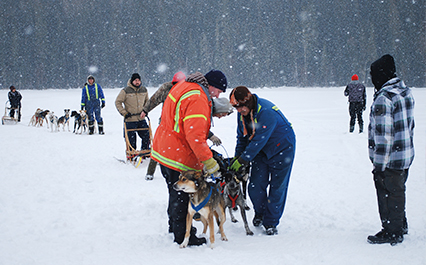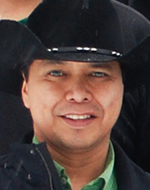Page Content
CTS teacher Kayley Van Schaik (left) and Grade 11 students Celeste Anderson, of Atikameg School (right), and Shenatah Cardinal, of Cadotte Lake School, learn how to build a quinzhee, a hut of boughs and snow that could be used for winter survival.
Northern division pursuing land-based learning
The last six months have been an eye-opening experience for Jason Bigcharles. After spending the first eight years of his teaching career in a traditional classroom setting, the 41-year-old is now co-ordinating an effort to bring experiential learning to students in the Northland School Division.
This focus on learning about the land and traditional aboriginal practices has seen Bigcharles organize several wilderness camps for student groups.
At a recent camp at the Marten Lakes Wilderness Campus near Slave Lake, elders, educators and community members shared wisdom in areas like meal preparation, ice fishing, snowshoeing, building survivor shelters, dogsledding, trapping, hand games, Cree language development, storytelling and traditional art. The camp involved high school students from Little Buffalo School, Atikameg School and Cadotte Lake School and followed a brief introduction to these outdoor concepts in a classroom setting.

Little Buffalo School teacher Colin Mackay (left) and Cree language, culture and literacy instructor Kevin Lewis prepare for a dog sledding run around Marten Lakes, near Slave Lake.
“When we did take them out to the camps, get out on the land focused on land-based learning, we noticed a phenomenal jump in the level of student engagement,” Bigcharles said.
Most of the students taking part in the camps are aboriginal, but the vast majority of them have little knowledge of these traditional practices, Bigcharles says.
“I’d say maybe 10 per cent of our aboriginal students are aware of their cultural practices or past cultural practices … so it’s an alarmingly low number that actually know about these things.”
But the students are very interested in what they’re learning. They’re going back to their schools and lobbying their teachers and principals for more. Bigcharles is now hearing from many principals who are interested in getting their schools involved in hands-on learning of aboriginal culture and practices.
“It’s something that the elders within our communities have been really pushing hard for, and as program providers, we’re starting to see why they’re pushing so hard, because the kids are constantly asking for either further teachings or more in-depth teachings.”
And while he’s purposely avoided getting into the religious or spiritual aspects of aboriginal culture, those are aspects that students are demanding to learn about as well, Bigcharles says.
“That was interesting to see them bring that to the table themselves.”
Curriculum
The camps have been organized to deliver on the curricular elements of language and culture, literacy and numeracy.
The literacy component is addressed through storytelling and report writing after the camps. Numeracy is built into some of the lessons. For example, students learning how to set up a snare must measure its circumference, diameter and distance from the trail, as well as the trail length.
As Bigcharles continues to develop the program, he’s looking to build a logical progression of activities that follows the seasonal rounds of the Woodland Cree people. His primary focus at the moment is to develop effective assessment tools.
“That’s something we’re having a little bit of trouble with, especially when it comes to culture. How do you assess culture? That’s been a difficult question,” he says.
As he works to address the various challenges of growing the program, he’s working hard to convey the message that land-based lessons involve real learning and are not simply recreational activities, a perception that’s persisted in the past.
“We want to make sure that land-based learning is just as credible as any other programming in the schools,” he says.
For him, there’s no question that real learning takes place at these camps, and the engagement he’s seen has been eye opening.
“One of the biggest questions on the minds of educators is, how do I engage my students? That’s one question that’s really been answered for me these past few months,” Bigcharles says.
“Experiential learning — I think that’s the way to go.” ❚
 Jason Bigcharles is an outdoor education/Cree culture specialist with the Kee Tas Kee Now Tribal Council, which is a council representing six first nations in remote parts of northern Alberta. Through a partnership agreement formed in 2012, the Northland School Division helps provide education programming in schools in the council’s communities.
Jason Bigcharles is an outdoor education/Cree culture specialist with the Kee Tas Kee Now Tribal Council, which is a council representing six first nations in remote parts of northern Alberta. Through a partnership agreement formed in 2012, the Northland School Division helps provide education programming in schools in the council’s communities.
